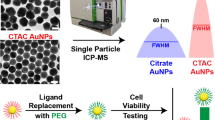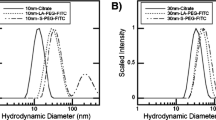Abstract
Surface characteristics of a nanoparticle, such as functionalization with polyethylene glycol (PEG), are critical to understand and achieve optimal biocompatibility. Routine physicochemical characterization such as UV-vis spectroscopy (for gold nanoparticles), dynamic light scattering, and zeta potential are commonly used to assess the presence of PEG. However, these techniques are merely qualitative and are not sensitive enough to distinguish differences in PEG quantity, density, or presentation. As an alternative, two methods are described here which allow for quantitative measurement of PEG on PEGylated gold nanoparticles. The first, a displacement method, utilizes dithiothreitol to displace PEG from the gold surface. The dithiothreitol-coated gold nanoparticles are separated from the mixture via centrifugation, and the excess dithiothreitol and dissociated PEG are separated through reversed-phase high-performance liquid chromatography (RP-HPLC). The second, a dissolution method, utilizes potassium cyanide to dissolve the gold nanoparticles and liberate PEG. Excess CN−, Au(CN)2 −, and free PEG are separated using RP-HPLC. In both techniques, the free PEG can be quantified against a standard curve using charged aerosol detection. The displacement and dissolution methods are validated here using 2-, 5-, 10-, and 20-kDa PEGylated 30-nm colloidal gold nanoparticles. Further value in these techniques is demonstrated not only by quantitating the total PEG fraction but also by being able to be adapted to quantitate the free unbound PEG and the bound PEG fractions. This is an important distinction, as differences in the bound and unbound PEG fractions can affect biocompatibility, which would not be detected in techniques that only quantitate the total PEG fraction.

Displacement and dissolution techniques to quantitate PEG on AuNPs. a The displacement method uses excess DTT to displace PEG from the surface of the gold nanoparticle. The displaced PEG and excess DTT (supernatant fraction) are separated from the gold nanoparticle (pellet fraction) by centrifugation. RPHPLC with CAD is used to separate and quantitate the PEG component. b The dissolution method used potassium cyanide (KCN) to dissolve the gold nanoparticle. The resulting mixture is then separated using RPHPLC and the PEG component is quantitated using CAD





Similar content being viewed by others
References
Qian W, Murakami M, Ichikawa Y, Che Y (2011) Highly efficient and controllable PEGylation of gold nanoparticles prepared by femtosecond laser ablation in water. J Phys Chem C 115(47):23293–23298
Blanco E, Hsiao A, Mann AP, Landry MG, Meric-Bernstam F, Ferrari M (2011) Nanomedicine in cancer therapy: innovative trends and prospects. Cancer Sci 102(7):1247–1252
Onoue S, Yamada S, Chan HK (2014) Nanodrugs: pharmacokinetics and safety. Int J Nanomedicine 9:1025–1037
Albanese A, Tang PS, Chan WCW (2012) The effect of nanoparticle size, shape, and surface chemistry on biological systems. Annu Rev Biomed Eng 14:1–16
Harris JM, Chess RB (2003) Effect of pegylation on pharmaceuticals. Nat Rev Drug Discov 2(3):214–221
Jokerst JV, Lobovkina T, Zare RN, Gambhir SS (2011) Nanoparticle PEGylation for imaging and therapy. Nanomedicine-UK 6(4):715–728
Yowell SL, Blackwell S (2002) Novel effects with polyethylene glycol modified pharmaceuticals. Cancer Treat Rev 28:3–6
van Vlerken LE, Amiji MM (2006) Multi-functional polymeric nanoparticles for tumour-targeted drug delivery. Expert Opin Drug Deliv 3(2):205–216
Cai W, Gao T, Hong H, Sun J (2008) Applications of gold nanoparticles in cancer nanotechnology. Nanotechnol Sci Appl 2008 (1)
Jain S, Hirst DG, O’Sullivan JM (2012) Gold nanoparticles as novel agents for cancer therapy. Br J Radiol 85(1010):101–113
Almeida JP, Figueroa ER, Drezek RA (2014) Gold nanoparticle mediated cancer immunotherapy. Nanomedicine-UK 10(3):503–514
Gatoo MA, Naseem S, Arfat MY, Mahmood Dar A, Qasim K, Zubair S (2014) Physicochemical properties of nanomaterials: implication in associated toxic manifestations. BioMed Res Int 2014:498420
McNeil SE (2009) Nanoparticle therapeutics: a personal perspective. WIREs Nanomed Nanobiotechnol 1(3):264–271
Adiseshaiah P, Hall JB, McNeil S (2010) Nanomaterial standards for efficacy and toxicity assessment. WIREs Nanomed Nanobiotechnol 2(1):99–112
Dobrovolskaia MA, Patri AK, Potter TM, Rodriguez JC, Hall JB, McNeil SE (2012) Dendrimer-induced leukocyte procoagulant activity depends on particle size and surface charge. Nanomedicine (London) 7(2):245–256
Dobrovolskaia MA, Patri AK, Simak J, Hall JB, Semberova J, De Paoli Lacerda SH, McNeil SE (2012) Nanoparticle size and surface charge determine effects of PAMAM dendrimers on human platelets in vitro. Mol Pharm 9(3):382–393
Holgate ST (2010) Exposure, uptake, distribution and toxicity of nanomaterials in humans. J Biomed Nanotechnol 6(1):1–19
Kobayashi H, Brechbiel MW (2003) Dendrimer-based macromolecular MRI contrast agents: characteristics and application. Mol Imaging 2(1):1–10
Paciotti GF, Myer L, Weinreich D, Goia D, Pavel N, McLaughlin RE, Tamarkin L (2004) Colloidal gold: a novel nanoparticle vector for tumor directed drug delivery. Drug Deliv 11(3):169–183
Petros RA, DeSimone JM (2010) Strategies in the design of nanoparticles for therapeutic applications. Nat Rev Drug Discov 9(8):615–627
Kamaly N, Xiao ZY, Valencia PM, Radovic-Moreno AF, Farokhzad OC (2012) Targeted polymeric therapeutic nanoparticles: design, development and clinical translation. Chem Soc Rev 41(7):2971–3010
Clogston JD, Patri AK (2013) Importance of physicochemical characterization prior to immunological studies. In: Dobrovolskaia MA, McNeil SE (eds) Handbook of immunological properties of engineered nanomaterials. Frontiers in Nanobiomedical Research, vol 1. World Scientific Publishing, pp 25–52. doi:10.1142/9789814390262_0002
Alexis F, Pridgen E, Molnar LK, Farokhzad OC (2008) Factors affecting the clearance and biodistribution of polymeric nanoparticles. Mol Pharm 5(4):505–515
Moghimi SM, Hunter AC, Andresen TL (2012) Factors controlling nanoparticle pharmacokinetics: an integrated analysis and perspective. Annu Rev Pharmacol Toxicol 52:481–503
Bertrand N, Wu J, Xu XY, Kamaly N, Farokhzad OC (2014) Cancer nanotechnology: the impact of passive and active targeting in the era of modern cancer biology. Adv Drug Deliv Rev 66:2–25
Li SK, Yang ZJ, Sun XH, Tan YY, Yagi SG, Hoffman RM (2003) A simultaneous colorimetric assay of free and protein-coupled polyethylene glycol. Anal Biochem 313(2):335–337
Nag A, Mitra G, Ghosh PC (1996) A colorimetric assay for estimation of polyethylene glycol and polyethylene glycolated protein using ammonium ferrothiocyanate. Anal Biochem 237(2):224–231
Protocol E https://www.piercenet.com/instructions/2160311.pdf
Schoenfisch MH, Pemberton JE (1998) Air stability of alkanethiol self-assembled monolayers on silver and gold surfaces. J Am Chem Soc 120(18):4502–4513
Zhang B, Zhang H, Myers BK, Elupula R, Jayawickramarajah J, Grayson SM (2014) Determination of polyethylene glycol end group functionalities by combination of selective reactions and characterization by matrix assisted laser desorption/ionization time-of-flight mass spectrometry. Anal Chim Acta 816:28–40
Su YC, Chen BM, Chuang KH, Cheng TL, Roffler SR (2010) Sensitive quantification of PEGylated compounds by second-generation anti-poly(ethylene glycol) monoclonal antibodies. Bioconjug Chem 21(7):1264–1270
Tiwari K, Shebannavar S, Kattavarapu K, Pokalwar S, Mishra M, Chauhan UKS (2012) Simultaneous detection of free polyethylene glycol and PEGylated proteins by western blot. J Sci Ind Res India 71(6):392–395
Rahme K, Chen L, Hobbs RG, Morris MA, O’Driscoll C, Holmes JD (2013) PEGylated gold nanoparticles: polymer quantification as a function of PEG lengths and nanoparticle dimensions. Rsc Adv 3(17):6085–6094
Manson J, Kumar D, Meenan BJ, Dixon D (2011) Polyethylene glycol functionalized gold nanoparticles: the influence of capping density on stability in various media (vol 44, pg 99, 2011). Gold Bull 44(3):195–196
Levin CS, Bishnoi SW, Grady NK, Halas NJ (2006) Determining the conformation of thiolated poly(ethylene glycol) on Au nanoshells by surface-enhanced Raman scattering spectroscopic assay. Anal Chem 78(10):3277–3281
Rabanel JM, Hildgen P, Banquy X (2014) Assessment of PEG on polymeric particles surface, a key step in drug carrier translation. J Control Release Off J Control Release Soc 185:71–87
Cheng TL, Chuang KH, Chen BM, Roffler SR (2012) Analytical measurement of PEGylated molecules. Bioconjug Chem 23(5):881–899
Kou DW, Manius G, Zhan SD, Chokshi HP (2009) Size exclusion chromatography with Corona charged aerosol detector for the analysis of polyethylene glycol polymer. J Chromatogr A 1216(28):5424–5428
Diaz-Lopez R, Libong D, Tsapis N, Fattal E, Chaminade P (2008) Quantification of pegylated phospholipids decorating polymeric microcapsules of perfluorooctyl bromide by reverse phase HPLC with a charged aerosol detector. J Pharm Biomed Anal 48(3):702–707
Barman BN, Champion DH, Sjoberg SL (2009) Identification and quantification of polyethylene glycol types in polyethylene glycol methyl ether and polyethylene glycol vinyl ether. J Chromatogr A 1216(40):6816–6823
Zabaleta V, Campanero MA, Irache JM (2007) An HPLC with evaporative light scattering detection method for the quantification of PEGs and Gantrez in PEGylated nanoparticles. J Pharm Biomed 44(5):1072–1078
Kattavarapu K, Shebannavar SN, Kushwaha H, Pokalwar S, Mishra K, Mishra T, Mishra MK (2012) Validation of size exclusion high performance liquid chromatography for quantification of free polyethylene glycol in PEGylated recombinant human granulocyte colony stimulating factor. IJSID 2(1):6–11
Li N, Ziegemeier D, Bass L, Wang W (2008) Quantitation of free polyethylene glycol in PEGylated protein conjugate by size exclusion HPLC with refractive index (RI) detection. J Pharm Biomed Anal 48(5):1332–1338
Tsai DH, Shelton MP, DelRio FW, Elzey S, Guha S, Zachariah MR, Hackley VA (2012) Quantifying dithiothreitol displacement of functional ligands from gold nanoparticles. Anal Bioanal Chem 404(10):3015–3023
Kang KA, Wang J, Jasinski JB, Achilefu S (2011) Fluorescence manipulation by gold nanoparticles: from complete quenching to extensive enhancement. J Nanobiotechnol 9:16
Schneider G, Decher G, Nerambourg N, Praho R, Werts MHV, Blanchard-Desce M (2006) Distance-dependent fluorescence quenching on gold nanoparticles ensheathed with layer-by-layer assembled polyelectrolytes. Nano Lett 6(3):530–536
Thaxton CS, Daniel WL, Giljohann DA, Thomas AD, Mirkin CA (2009) Templated spherical high density lipoprotein nanoparticles. J Am Chem Soc 131(4):1384–1385
Tsai DH, Davila-Morris M, DelRio FW, Guha S, Zachariah MR, Hackley VA (2011) Quantitative determination of competitive molecular adsorption on gold nanoparticles using attenuated total reflectance-Fourier transform infrared spectroscopy. Langmuir 27(15):9302–9313
Shi B, Fang C, Pei YY (2006) Stealth PEG-PHDCA niosomes: effects of chain length of PEG and particle size on niosomes surface properties, in vitro drug release, phagocytic uptake, in vivo pharmacokinetics and antitumor activity. J Pharm Sci 95(9):1873–1887
Acknowledgments
The authors are grateful to Sarah Anderson, Matthew Hansen, and Simona Colantonio for TEM, ICP-MS, and MALDI-TOF MS analysis, respectively, and Joseph Meyer for graphic illustrations. This project has been funded in whole or in part with federal funds from the National Cancer Institute, National Institutes of Health, under Contract No. HHSN261200800001E. The content of this publication does not necessarily reflect the views or policies of the Department of Health and Human Services, nor does mention of trade names, commercial products, or organizations imply endorsement by the US Government.
Author information
Authors and Affiliations
Corresponding author
Rights and permissions
About this article
Cite this article
Smith, M.C., Crist, R.M., Clogston, J.D. et al. Quantitative analysis of PEG-functionalized colloidal gold nanoparticles using charged aerosol detection. Anal Bioanal Chem 407, 3705–3716 (2015). https://doi.org/10.1007/s00216-015-8589-2
Received:
Revised:
Accepted:
Published:
Issue Date:
DOI: https://doi.org/10.1007/s00216-015-8589-2




